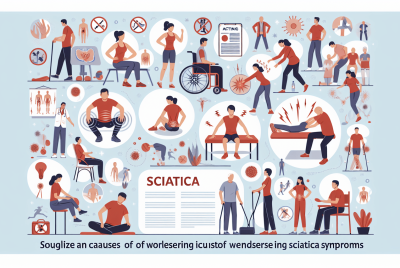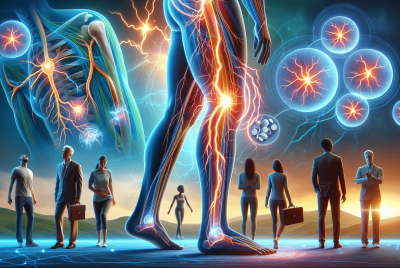Sciatica: A Comprehensive Overview
Introduction
Living with chronic back pain caused by sciatica can be debilitating and greatly impact one’s quality of life. As a researcher and advisor around the condition, I aim to provide a comprehensive overview of sciatica, including its definition, causes, and available treatment options. By understanding this condition, individuals can make informed decisions regarding their health and seek appropriate care. I hope this article; Sciatica: A Comprehensive Overview helps demystify this painful condition giving you hope & confidence that effective management & treatments exist.
Understanding Sciatica
Sciatica refers to the pain that originates in the lower back and radiates down through the buttocks, often extending into one leg. It occurs due to the compression or irritation of the sciatic nerve, which is the largest nerve in the body. The sciatic nerve runs from the lower back, through the buttocks, and down to the feet. When this nerve is affected, it can cause various symptoms and discomfort.
Anatomy of the Sciatic Nerve
To understand sciatica better, it’s important to grasp the anatomy of the sciatic nerve. The nerve originates from the spinal cord in the lower back and is composed of several nerve roots that exit the spinal column. These nerve roots converge to form the sciatic nerve, which then branches out into the lower extremities. The compression or irritation of the nerve roots can lead to sciatic pain.
Causes of Sciatica
Sciatica can have several underlying causes, including herniated discs, spinal stenosis, degenerative disc disease, spondylolisthesis, and piriformis syndrome. A herniated disc occurs when the soft inner core of a spinal disc protrudes through the outer layer, pressing on the adjacent nerve roots. Spinal stenosis refers to the narrowing of the spinal canal, causing compression of the nerve roots. Degenerative disc disease is characterized by the breakdown of the spinal discs over time. Spondylolisthesis occurs when one vertebra slips forward over the one below it, potentially compressing the nerve roots. Lastly, piriformis syndrome involves the piriformis muscle compressing the sciatic nerve.
Risk Factors
Certain factors can increase the risk of developing sciatica. Advancing age is a common risk factor, as the spinal discs tend to degenerate and become more susceptible to herniation. Occupations that involve heavy lifting, prolonged sitting, or repetitive movements can also contribute to the development of sciatica. Additionally, obesity and a sedentary lifestyle can increase the risk of sciatic pain. Understanding these risk factors can help individuals take preventive measures to reduce their likelihood of developing sciatica.
Symptoms of Sciatica
Sciatica is characterized by various symptoms that can vary in intensity and duration. Common symptoms include radiating pain along the path of the sciatic nerve, numbness and tingling sensations, muscle weakness in the affected leg, and changes in reflexes. The pain may worsen with movement, such as walking or bending. It is important to differentiate sciatica from other causes of back pain, as the appropriate treatment approach depends on an accurate diagnosis.
Diagnosis and Evaluation
When experiencing symptoms of sciatica, it is crucial to consult a healthcare professional for an accurate diagnosis. The evaluation typically involves a detailed medical history, a physical examination, and diagnostic imaging tests such as X-rays, MRI scans, or CT scans. In some cases, electromyography (EMG) and nerve conduction studies may be performed to assess nerve function and identify specific areas of compression or irritation.
Non-Surgical Treatments
Non-surgical treatments are often the initial approach to managing sciatica. These options focus on pain relief, reducing inflammation, and promoting healing. Nonsteroidal anti-inflammatory drugs (NSAIDs) and oral corticosteroids may be prescribed to alleviate pain and reduce inflammation. Physical therapy is a key component of treatment, involving exercises, stretches, and modalities to strengthen the back muscles, improve flexibility, and promote proper posture. Chiropractic care, including spinal adjustments and manipulations, can also provide relief for some individuals.
Medications for Pain Relief
Medications can play a vital role in managing the pain associated with sciatica. Over-the-counter pain relievers, such as acetaminophen and nonsteroidal anti-inflammatory drugs (NSAIDs) like ibuprofen, can help reduce pain and inflammation. In more severe cases, prescription medications such as muscle relaxants or opioid analgesics may be prescribed. It is important to discuss the potential risks and benefits of medication with a healthcare provider and follow the recommended dosage guidelines.
Physical Therapy
Physical therapy is an essential component of sciatica treatment. A skilled physical therapist can create a personalized exercise program to strengthen the muscles supporting the spine, improve flexibility, and promote proper body mechanics. The therapy may include stretching exercises, low-impact aerobic activities, and specific movements to alleviate sciatic pain. Heat or cold therapy, ultrasound, and electrical stimulation may also be used as part of the treatment plan.
Chiropractic Care
Chiropractic care is another non-surgical approach that focuses on the diagnosis, treatment, and prevention of mechanical disorders of the musculoskeletal system, particularly the spine. Chiropractors use manual adjustments and manipulations to restore proper spinal alignment, alleviate nerve compression, and reduce pain. They may also incorporate other therapies, such as massage, traction, and exercises, into the treatment plan.
Alternative Therapies
In addition to conventional treatments, certain alternative therapies can complement sciatica management. Acupuncture, an ancient Chinese practice, involves inserting thin needles into specific points in the body to stimulate nerve function and promote pain relief. Massage therapy can help relax tight muscles and improve blood flow to the affected area, potentially reducing pain and inflammation. Other alternative therapies, such as herbal remedies, yoga, and meditation, may also provide relief and improve overall well-being.
Surgical Options
Surgery for sciatica is usually considered when non-surgical treatments fail to provide adequate relief or when there is a progressive neurological deficit. The specific surgical procedure depends on the underlying cause of sciatica. Common surgical options include microdiscectomy, which involves removing a portion of a herniated disc; laminectomy, which aims to decompress the spinal canal; spinal fusion, where two or more vertebrae are fused together; and artificial disc replacement, which replaces a damaged disc with an artificial one. It is important to thoroughly discuss the risks, benefits, and expected outcomes with a qualified surgeon.
Lifestyle Modifications
Adopting certain lifestyle modifications can contribute to managing and preventing sciatica. Maintaining a healthy weight helps reduce stress on the spine and decrease the risk of disc herniation. Engaging in regular exercise, such as walking, swimming, or cycling, can strengthen the back muscles, improve flexibility, and support spinal health. Practicing proper body mechanics, such as using proper lifting techniques and maintaining good posture, can also prevent unnecessary strain on the spine. Additionally, quitting smoking and managing stress levels are beneficial for overall spine health and reducing inflammation.
Coping with Sciatica
Living with sciatica can be challenging, both physically and emotionally. It is essential to develop coping strategies to manage the pain and maintain a positive outlook. Engaging in activities that provide joy and relaxation, such as hobbies, meditation, or spending time with loved ones, can help distract from the pain and improve overall well-being. Seeking support from healthcare professionals, support groups, or counseling services can also assist in navigating the challenges associated with chronic pain.
Conclusion
In conclusion, sciatica is a condition that can cause significant back pain and discomfort. Understanding the underlying causes, symptoms, and available treatment options is crucial for effectively managing sciatica. Non-surgical treatments, including medications, physical therapy, and chiropractic care, are often the initial approach to alleviate pain and promote healing. In some cases, surgical intervention may be necessary. Adopting lifestyle modifications and incorporating alternative therapies can also contribute to long-term management and prevention of sciatica. Remember, it is important to consult with healthcare professionals for an accurate diagnosis and personalized treatment plan.
FAQs
- Can sciatica be cured completely?
- Answer: While sciatica can often be managed effectively, a complete cure depends on the underlying cause and individual circumstances.
- How long does it take to recover from sciatica?
- Answer: Recovery time varies based on the severity of the condition and chosen treatment options. It can range from a few weeks to several months.
- Can exercise worsen sciatic pain?
- Answer: Certain exercises can aggravate sciatic pain, but proper guidance from a healthcare professional can help identify suitable exercises for relief and recovery.
- Is surgery the only option for sciatica?
- Answer: Surgery is typically considered when conservative treatments fail to alleviate symptoms. Many cases can be managed without surgical intervention.
- Can sciatica recur after successful treatment?
- Answer: Sciatica can recur if the underlying cause is not addressed or if preventive measures are not followed. Regular self-care and healthy lifestyle choices are essential.
(Note: The above article provides a comprehensive overview of sciatica, offering information based on research and advisory expertise. It is always recommended to consult a healthcare professional for accurate diagnosis and treatment.)




